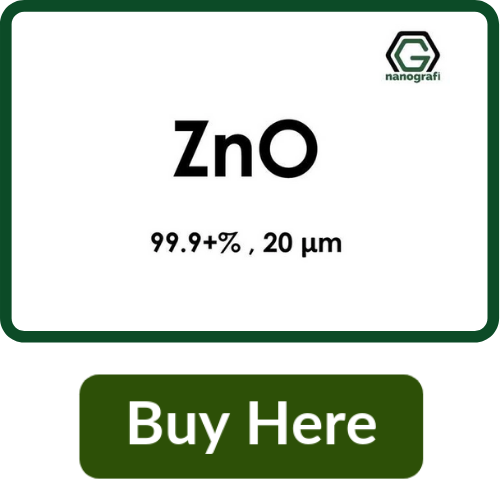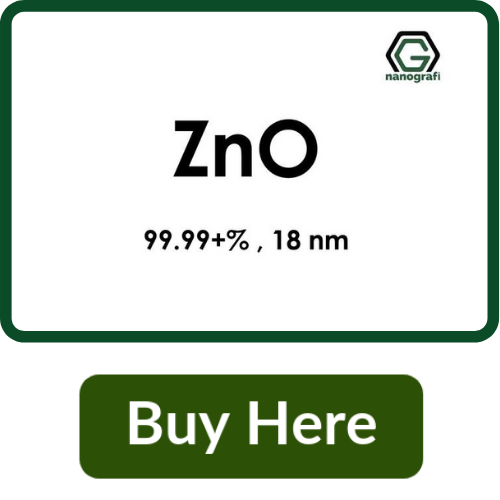Analyzed: Zinc Oxide and its Production, Properties, and Applications
Zinc oxide is an important material in various different
industries. Nano and microparticles of zinc oxide are obtained by different
production methods and acquire different properties. Exploiting these
properties enables different applications.
Zinc Oxide
Zinc Oxide (ZnO) is an odorless solid with yellowish-grey appearance. It is naturally found in nature as mineral zincite but, most of the zinc oxide supply is produced artificially [1]. Industrial large-scale production of ZnO follows three different routes; pyrometallurgical synthesis, hydrometallurgical synthesis, and as a by-product of other chemical reactions.
Pyrometallurgical synthesis is achieved through the direct process, indirect process or spray pyrolysis. Most of the ZnO is produced through the indirect process. In this process, the raw material is zinc metal. Zinc metal is vaporized in a container and exposed to air for rapid oxidation. This is a typical combustion process. Combusted zinc is the cooled down to obtained ZnO powder. The quality of the end product strongly depends on the quality of raw material. High-purity (>99%) zinc oxide product can be achieved only if a high-purity feedstock is used. ZnO particles produced through the indirect method are primarily in the size range of 30-2000 nm. The size of the particle can be manipulated by controlling airflow and flame turbulence. The second-largest production of ZnO is through direct process. The direct process uses zinc-containing wastes as feedstock. In this process, zinc metal is produced by reduction as a first step. Then, the metal compound is vaporized and oxidized with the same fashion as the indirect process. Spray pyrolysis thermally decomposes zinc salts to ZnO. Through this process, uniform particles with a high surface area can be obtained.
Even though it is a cheaper process than pyrometallurgical processes, hydrometallurgical synthesis is not as commonly used for ZnO production. This is because the end product is nor pure enough, contains a considerable amount of water, and has an irregular structure. However, this process is preferred in some industries because of the chemical activity and high surface area of the product. This high-surface-area product is defined as active zinc-oxide. Production of active zinc-oxide is a two-step process. The first step is the calcination of zinc wastes to hydrozincite and the second step is the decomposition of hydrozincite. ZnO is also obtained as a by-product of sodium dithionite synthesis. Zinc carbonate precipitates as a result of this process and then ZnO is obtained after filtering, drying and calcination or alkali treatment.
Small scale production methods are also available for ZnO production. Precipitation, solvent extraction, thin film deposition, and gas-phase synthesis are amongst these small scale processes[2].
ZnO nanomaterials are produced through physical, chemical or biological methods. Physical methods include; physical vapor deposition, arc-plasma method, thermal evaporation, and ultrasonic irradiation. The thermal evaporation method is suitable for the production of ZnO nanotubes with photocatalytic properties. This process is also simple, low cost and catalyst-free. Chemical production methods such as microemulsion, sol-gel, precipitation, chemical reduction, and chemical vapor deposition are also used for the production of ZnO nanostructures[3].
Properties of Zinc Oxide
Properties of ZnO particles change depending on production conditions. The physical and chemical properties of ZnO are tuned by taking advantage of this. So the use of ZnO particles is attractive to many different industries.
Three different crystal structure is available for ZnO; hexagonal wurtzite, cubic zinc-blende structure, and cubic rock-salt structure.
The morphology of ZnO particles can vary greatly. ZnO particles produced through pyrometallurgical processes can have nodular or needle type shapes while Active ZnO particles produced through hydrometallurgical processes have porous structures. The nanosized ZnO particles have a myriad of variety some of which can be listed as; nanotubes, nanowires, nanosheets, nanobelts and so on [2].
The heat capacity and thermal conductivity of ZnO are very high while the thermal expansion coefficient of the material is relatively low. An important thermal property of ZnO is its thermochromism. Due to crystal lattice defects, the color of ZnO changes from white to yellow reversibly.
Zinc oxide is a well-known semiconductor. ZnO also shows piezoelectricity and pyroelectricity.
Under normal conditions, zinc oxide is a hydrophilic compound. However, treatment with fatty acids can induce hydrophobicity.
ZnO nanoparticles exhibit antibacterial properties. ZnO effects bacteria by either blocking their food source or disrupting their cell membranes. Gram-negative bacteria are more sensitive to ZnO nanoparticles than gram-positive bacteria because of their peptidoglycan layer.
Zinc oxide is considered to be non-toxic to humans and animals. It doesn’t cause irritation to skin and eyes. However, it can cause coughing, fever, and chest pain upon inhalation and ingestion. The most important impact of zinc oxide is on aquatic organisms. Recently, zinc oxide has been held responsible for coral bleaching [4].
Applications of Zinc Oxide
The tunable properties of ZnO create the potential of its use in various different areas. Today, ZnO is majorly used in the rubber industry while the ceramic industry is the second in the line. In addition to these industries, ZnO is used in cosmetic and pigment industries, in dye synthesized solar cells, LEDs, UV lasers, phosphors, catalysts, and water disinfectant materials.
Read more about Zinc Oxide Powders
Rubber Industry
In the rubber industry, ZnO is used as a vulcanizing activator. It is also used as a cross-linking agent for elastomers such as neoprene and polysulfide. ZnO reduces water absorption of cable insulators and consequently improve its lifetime. ZnO addition also improves the thermal conductivity and abrasion resistance of rubber. Recently, the use of ZnO nanoparticles is considered for these applications in order to decrease zinc consumption.
Ceramics and Concrete Industry
Ceramics and concrete industries utilize low expansion coefficient, high thermal conductivity, and high thermal stability of ZnO particles. In ceramic applications, the low expansion coefficient of ZnO improves the elasticity of the material. When ZnO is added in small amounts it provides a glossy surface while in moderate amounts it provides a matte finish. Zinc oxide addition provides longer processing time and water resistance to concrete material. It is also used in quick-setting cement [2].
Pigment Industry
Even though it has been pushed to the sidelines by TiO2, ZnO is still an important element in the pigment industry. It is commonly used as a white pigment. However, due to the recent standards and specifications in the paint industry ZnO use is expected to decrease in this industry. On the other hand, ZnO has the potential to be used in energy-saving window coatings. Al or Ga doping increases the electrical conductivity of ZnO and provides the ability to reflect infrared radiation.
Cosmetics Industry
ZnO is widely used in the cosmetics industry as a broad-spectrum UV absorber. Because of this advantage, it is used in several cosmetic products such as moisturizers, make-up products, ointments, lip products, and hand creams. ZnO is affective both in UVA (320-400 nm) and UVB (290-320 nm). Another reason for the ZnO additives in cosmetic products is that it helps cosmetics to adhere to the skin more easily. Active ZnO is also used as an active ingredient in acne treatment products. Antibacterial and antifungal properties of ZnO nanoparticles are important in antibacterial products and fungal treatment lotions. Other application areas of ZnO nanoparticles in the cosmetic industry are; anti-dandruff shampoos, nappy rash creams, and deodorants[2].
Catalyst Applications
ZnO catalysts are used in methanol production. Hydrogenation of carbon monoxide is catalyzed by a mixture of zinc and chromium oxides. Also, alkali promoted ZnO is used as a catalyst for iso-butyl production from synthesis gas. ZnO is also used to catalyze the production of caprolactam which is then further processed to obtain nylon 6.
Water Disinfectant
Antibacterial properties of ZnO nanoparticles are used in the disinfection of water. It is suitable for the application because it is very active even in small amounts, stable under harsh conditions, and considered to be safe for humans and animals. The disinfection mechanism of ZnO is based on the elimination of reactive oxygen species (ROS), the release of Zn2+ and damaging bacterial cell walls [5].
Check an article review on Zinc Oxide CO2 Sensors
Other Application Areas
Zinc oxide nanoparticles can also be used as a substitute to TiO2 in dye synthesized solar cells. ZnO has a much higher electron diffusivity and high electron mobility. Because of these properties, ZnO is a suitable semiconductor for dye synthesized solar cells [6]. ZnO as a blue and UV light emitter has the potential to be used in light-emitting diodes (LEDs) and UV lasers. Another optical application of ZnO is as a precursor to phosphors. Seeing that zinc is an important micronutrient for humans, animals, and plants, pure ZnO additives are used in fertilizers, animal food, and dietary supplements.
Zinc oxide particles in both micro and nanoscale play an important role in the various industries. Different production processes provide different properties to ZnO products and open the doors to a myriad of applications. ZnO nanoparticles can show active behavior with the increased surface area. The activity of ZnO is important in catalytic applications or cosmetic products. Low expansion coefficient, high thermal stability, and thermal conductivity of ZnO are utilized by various different industries such as rubber, ceramic and concrete industries. Optical properties of ZnO are utilized in ceramics and pigment industries and LEDs, UV lasers, and phosphors. It is clear that ZnO particles hold a great part in both our daily life and in industrial applications. Further improvements of nanotechnology will allow different applications of ZnO particles while conventional production methods are expected to retain its importance in various applications.
References
1. Zinc Oxide. Available from: pubchem.ncbi.nlm.nih.gov/compound/zinc_oxi
2. Moezzi, A., A.M. McDonagh, and M.B. Cortie, Zinc oxide particles: Synthesis, properties and applications. Chemical engineering journal, 2012. 185: p. 1-22.
3. Król, A., et al., Zinc oxide nanoparticles: Synthesis, antiseptic activity and toxicity mechanism. Advances in colloid and interface science, 2017. 249: p. 37-52.
4. Skincare Chemicals and Coral Reefs. Available from: oceanservice.noaa.gov/news/sunscreen-coral
5. Dimapilis, E.A.S., et al., Zinc oxide nanoparticles for water disinfection. Sustainable Environment Research, 2018. 28(2): p. 47-56.
6. Vittal, R. and K.-C. Ho, Zinc oxide based dye-sensitized solar cells: A review. Renewable and Sustainable energy reviews, 2017. 70: p. 920-935.
Recent Posts
-
Advanced Materials for Unmanned Aerial Vehicle (UAV) Protection Against Laser
Consider a UAV on a critical mission, rendered inoperative by a sudden laser attack. With the increa …26th Jul 2024 -
Simulation and Modeling of Material Properties
Our world is composed of a dazzling array of materials, each with its own unique properties that dic …19th Jul 2024 -
Advanced Coatings for Superior Corrosion and Wear Resistance
Corrosion and wear pose significant challenges across various industries, leading to substantial eco …12th Jul 2024











